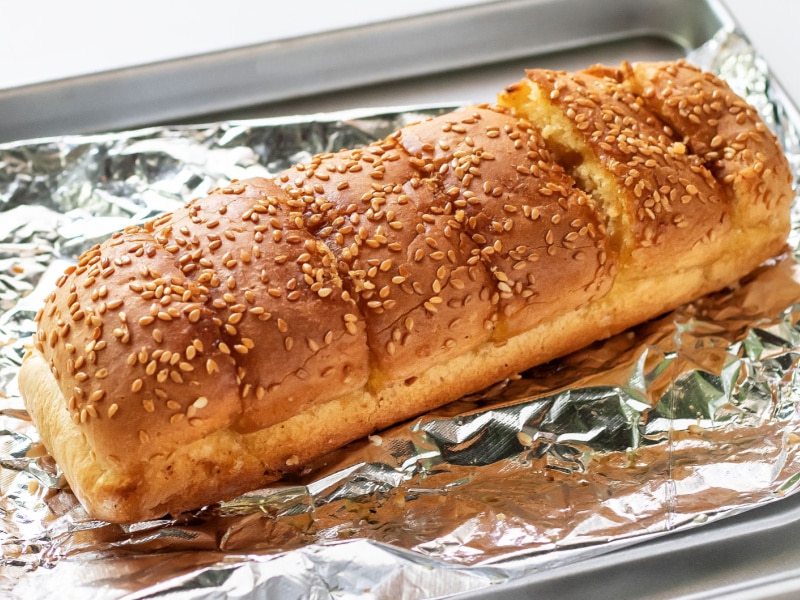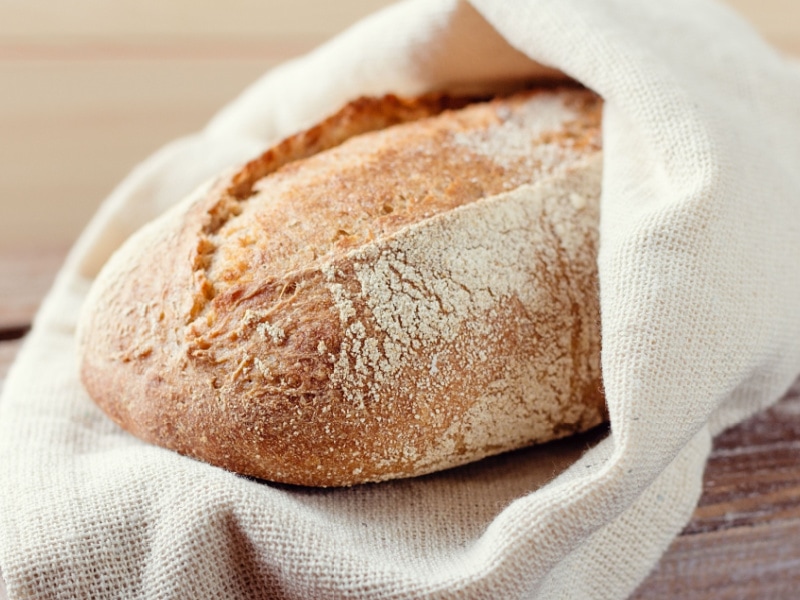If you’re wondering how to soften hard bread, there are two main methods that work like a charm. You can soften bread in the oven by getting it wet, wrapping it in foil, and baking it at 300 degrees Fahrenheit.
To soften bread in the microwave, wrap it in a moist paper towel and microwave it for 5-10 seconds.

There’s also a bonus “celery” method, which also works in a pinch.
So don’t be so quick to throw out a loaf that’s seemingly “past its prime.” With a little know-how, you can turn rock-hard bread into a delicious success.
Ready to take on stale bread? Let’s do this!
Why Does Bread Go Stale?
Alright, here’s a little bit of science for you.
The key ingredient in bread is starch. During baking, starch absorbs water, expands, and then gets thick and gelatinous as it cools. This gives bread its soft, spongy feel.
But with time, a process called retrogradation takes place.
Essentially, those starch molecules release some of the water they soaked up. This causes the moisture to slowly move up and evaporate from the bread’s surface.
As a result, the starch molecules return to their original structure, turning your lovely soft loaf into a tough, brittle disappointment.
How to Soften Hard Bread
Thankfully, there are a few simple ways to help soften hard bread. The secret lies in gently heating the loaf, allowing the starches to reabsorb water.
This reabsorption takes place at around 131 degrees Fahrenheit and continues up to around 185. So, the goal is to use a relatively low temperature to do it properly. Let’s take a closer look at the methods.

How to Soften Bread in the Oven
1. Inspect the bread: Check for molds, discoloration, or unusual smells. Discard it if any signs of spoilage are present.
2. Moisten the bread: Brush the bread with water, run it under a faucet for a few seconds (ideal for hard crusts like baguette or sourdough), or spritz it with a spray bottle filled with clean water.
3. Wrap the bread: Securely wrap the bread with aluminum foil, ensuring there are no gaps or holes.
4. Warm it up: Place the bread in the oven and set the heat to 300 degrees Fahrenheit. There’s no need to preheat the oven.
Allow the bread to warm for about 10 to 15 minutes. The bread absorbs the trapped moisture in the foil, making it soft.
5. Crisp the crust: Remove the foil when you’re satisfied with the bread’s softness.
Place the bread back into the oven for 5 more minutes to evaporate excess moisture and crisp up the crust.
6. Enjoy: Slice up your now-soft, warm bread and enjoy!

How to Soften Bread in the Microwave
1. Inspect the bread: Check for molds, discoloration, or unusual smells. If any signs of spoilage are present, it’s best to dispose of the bread.
2. Wrap bread with a moist paper towel: Get a clean paper towel and moisten it with cold water. Squeeze out any excess water so it’s damp, not dripping. Use it to wrap the bread.
3. Microwave: Place the wrapped bread in the microwave and set the timer for 5 seconds.
4. Check the softness: After 5 seconds, take the bread out of the microwave (be careful, as it will be hot) and check if it’s soft enough for your liking.
5. Repeat if necessary: If the bread isn’t soft enough, repeat the process, microwaving for another 5 seconds. Heat in short intervals to avoid overheating.
6. Enjoy: Slice up your now-soft, warm bread and enjoy!
Bonus: The Celery Method
Here’s another unique method to try! This hack works best for bags of bread.
It requires bit of time, though, so it’s not the best option if you’re in a hurry. Here’s how:
1. Insert celery stalks: Put 1 to 3 stalks of celery inside the bag of bread slices.
2. Seal the bag: Ensure the bag is tightly sealed with no air escaping.
3. Refrigerate: Leave the bag in the fridge for several hours, or even better, overnight.
4. Remove the celery: When you’re ready to eat the bread, open the bag and remove the celery stalk. The celery will have dried out and the bread should be softer.
5. Enjoy: You can eat the bread straight from the fridge or toast it if you prefer.
Tips for Softening Hard Bread
Here are some additional tips and tricks for reviving hard bread:
- Use a brown paper bag: If you’ve run out of aluminum foil, you can reheat a baguette using its brown paper bag packaging.
- Keep an eye on it: Whether you’re reheating bread in the microwave or the oven, keep an eye on it to avoid burning.
- Eat it quickly: Bread will return to its stale state once it cools down, so it’s best to consume it immediately after reheating.
- Limit reheating: Try not to reheat bread more than once, as each heating process diminishes the bread’s quality.
- Prioritize the oven method: If possible, soften bread in the oven rather than the microwave for the best texture.

How to Use Stale Bread
If all else fails, you can always use stale bread as it is. It’s not as useless as you think!
Make croutons: Slice the stale bread into ½ inch cubes. Coat them in some olive oil, put them on a baking sheet, and bake them for 3-5 minutes until toasted.
Create breadcrumbs: Grate stale bread on a cheese grater or use a food processor. Breadcrumbs are great for coating meat, thickening soup, or as a topping for casseroles.
Cook bread pudding: Chop stale bread, drizzle butter on it, and add raisins. In a separate bowl, combine eggs, milk, and vanilla.
Soak the bread in this mixture and then bake it for 45 minutes at 350 degrees Fahrenheit.
Make French toast: Stale bread soaks up the egg and milk mixture better without getting too soggy.
Dip the bread in a mixture of beaten eggs, milk, and a bit of sugar and cinnamon, then pan-fry it until it’s golden brown on each side.









